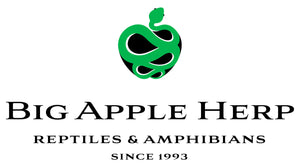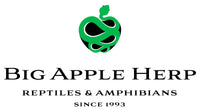Care Sheet For Green Tree Pythons
Green Tree Pythons are a small and slender species that are incredibly variable in color with most being green but with some having yellow and even blue colors. It's been the reputation of the Green Tree Python that they are somewhat vicious and aggressive. However, this reputation is undeserving for captive bred Green Tree Pythons since they are usually quite docile unless the handler does something that provokes it. The Green Tree Python are native to New Guinea, Indonesia and the northern tip of Australia and is almost entirely aboreal preferring to stay curled over a tree branch. In general, an adult Green Tree Python reaches sizes in the 4 to 6 foot range. At Big Apple Pet Supply, all our Green Tree Pythons are bred in house as we maintain a strict quality control. We highly recommend that you do not purchase wild caught Green Tree Pythons which typically do not do well in captivity, are aggressive and deplete the natural environment.
HOUSING
Baby and Juvenile Green Tree Pythons can be set up in an enclosure as small as a 20 gallon (30" x 12" x 12"H) but adults will need to be housed in an enclosure that is 18" x 18" x 18"H or 24" x 18" x 24"H. The most important thing in the GTP's cage is that you provide a secure and steady perch for this is where most of your snake's time will be spent. The perch should be about as thick as the thickest part of your snake's body. Since like most snakes, Green Tree Pythons are escape artists, a secure screen top is absolutely critical to keep your snake from escaping the enclosure. A Big Apple Acrylic Cage would make an ideal enclosure... we'll be happy to set you up with the correct cage, heating, lighting and accessories for your new pet.
SUBSTRATE
Some keepers of Green Tree Pythons prefer to use paper as their main substrate. However, you can use Zoo Med Aspen Snake Bedding, Repti-Bark, Forest Floor or Eco Earth (all located in our bedding section) but be careful to make sure that you keep these substrates clean and free from mold since the Green Tree Python's cage is normally high in humidity. We also recommend that you use Sphagnum Moss in your terrarium since this will help keep the humidity to proper levels.
HEATING
As with all reptiles, Green Tree Pythons need a thermal gradient consisting of a warm area (86 Deg. F) and a cool area (78 Deg. F). The best way to heat your Green Tree Python's enclosure is with a combination of a heat mat and ceramic heat emitter. We recommend the Intellitemp Heat Mat and Black Heat Ceramic Infrared Heat Emitter to accomplish the heating of your Green Tree Python's cage. The heat mat and ceramic heat emitter should be located on one side while the other side should not have any heat source. It is a good idea to control the ceramic emitter with a thermostat but make sure to purchase a quality thermometer to keep track of your warm and cool sides. Thermometers and thermostats are available in our heating supply section.
LIGHTING
Green Tree Pythons, like all snakes do no require a light or UV bulb. If you choose to add a basking bulb to add more light to your cage make sure that you maintain proper heat levels but not go over 88 deg. F as this could be detrimental to your snake's health.
SHELTER
Green Tree Pythons generally do not use hiding places since they spend almost all their time hanging out on branches (ie. the perch you provided).
SHEDDING
Like all reptiles and amphibians, Green Tree Pythons shed their entire skin all at once. Babies shed more often than adults because as babies they outgrow their skin faster. Snakes can normally shed off their skin easily but sometimes they have issues if they do not have the proper humidity while shedding. You need to check your snake after it has shed to make sure it was able to peel all the skin off, especially around their eyes. If not removed promptly serious issues can form if not taken care of properly. For this reason it is important to maintain a decent amount of humidity in the cage by misting a couple times a day. This is especially true around shedding time. You'll note shedding time when your snake's eyes turn a shade of blue and become cloudy.
Providing a misting system or fogging system is an important addition to your Green Tree Python's cage as it is critical to keep humidity at high levels. However, some find that humidity can be kept ot a high level by providing an oversized water bowl. We carry an excellent selection of misting and humidity devices in our Misters & Foggers section.
WATER
It is essential that you provide your Green Tree Python with a large water bowl. The bowl should be large enough that the Green Tree Python can soak its entire body in but not so big that it might have a difficult time getting in or out of the bowl. It's fine to have the bowl directly under the heat in the cage as this will help evaporate the water and create humidity.
FOOD
Green Tree Pythons eat mice and chicks so the size of the prey is dependent upon the girth of the snake. You should not feed your Green Tree Python anything bigger than the thickest part of its body. The prey item should leave a readily noticeable lump in the snake. This is fairly standard for all species of snakes. Hatchling snakes are typically fed every 5 days while adults should be typically fed every 10 days. However, it should be noted that some hobbyists feed adult snakes once a week.
Feeding live or pre-killed has been a question we are often asked. Everyone has their own opinion on this subject but we are emphatic that thawed frozen rodents is a much better option. First, feeding thawed rodents is easier and secondly it's substantially less expensive because you can purchase rats or mice in bulk and then store them in the freezer. However, more importantly, it is significantly safer for the snake. The bottom line is that a thawed mouse will never bite or chew on your snake in defense. We have seen nasty rodent bites inflicted on snakes when fed live rodents... we suggest you play it smart and go with feeding thawed prey items. We have a huge selection of frozen feeders that we deliver right to your door in our Frozen Feeders section of our website.
VITAMINS
It is important to feed high quality rodents to your snake but it is always a good idea to coat the rodent with a bit of vitamin and calcium powders before feeding them. We carry a full line of quality insect food and reptile vitamins and calcium in our Food section.
CAGE MAINTENANCE
Green Tree Pythons require minimal maintenance as they usually excrete small amounts of semi-solid fluid. Aspen and similar substrates allow for quick cleaning of feces and using one of our scoopers (for sale in our cleaning section) you can perform this task when defecation occurs. The bedding should be completely thrown out and the entire cage (including all accessories) should be washed with Quat Plus (available in our cleaning section) or a mild detergent at least once every four to five months. If using paper towels, change all paper towels at least once a week.
HIBERNATION
Hibernation is not natural for Green Tree Pythons in the wild so make sure you heat your Green Tree Pythons throughout the winter so that they continue to eat, drink and be active. A general reduction in feeding behavior is normal during winter months due to temperature fluctuations in your house. As long as they keep fairly consistent weight it is generally not an issue and normal feeding typically resume in the spring.


